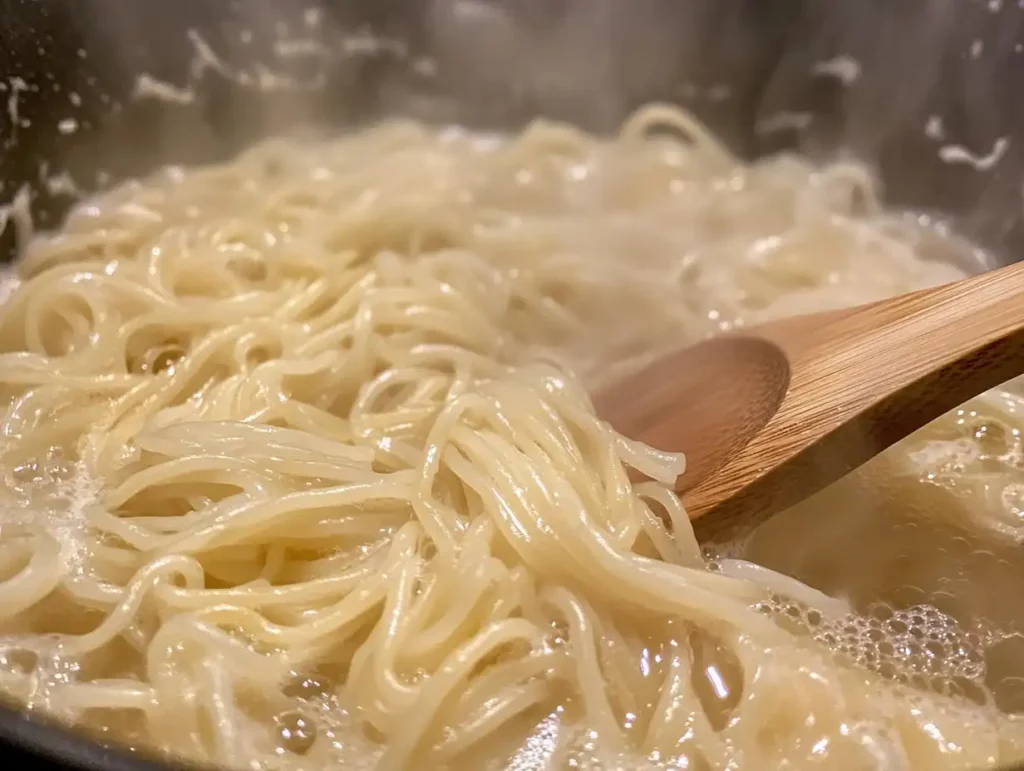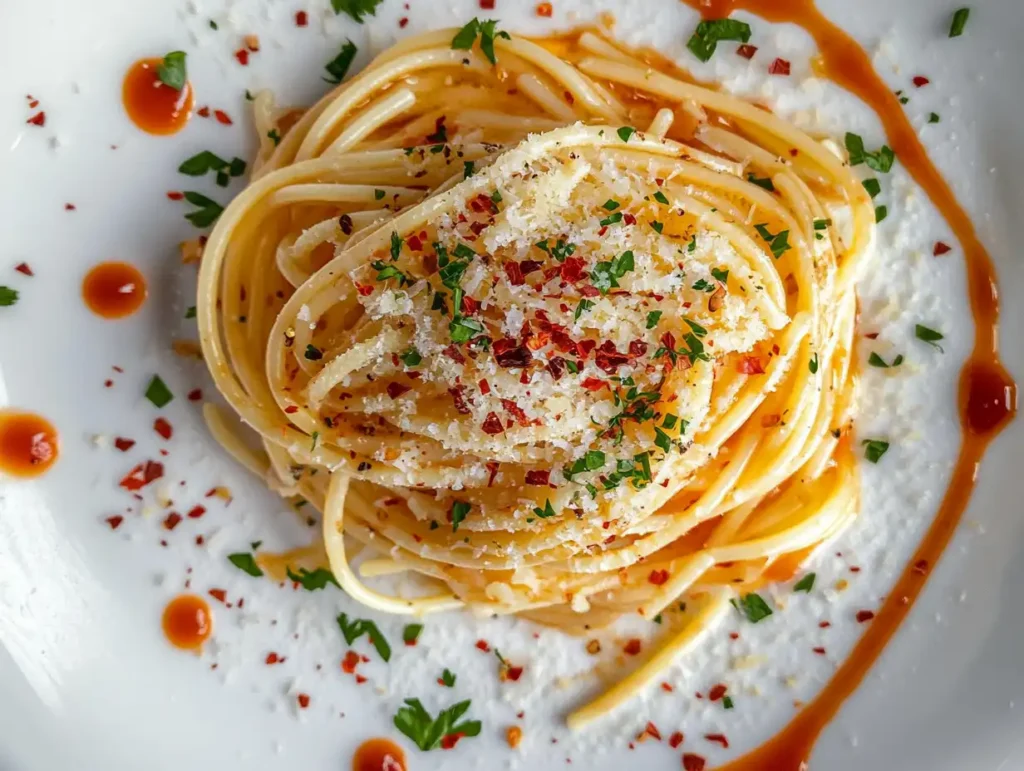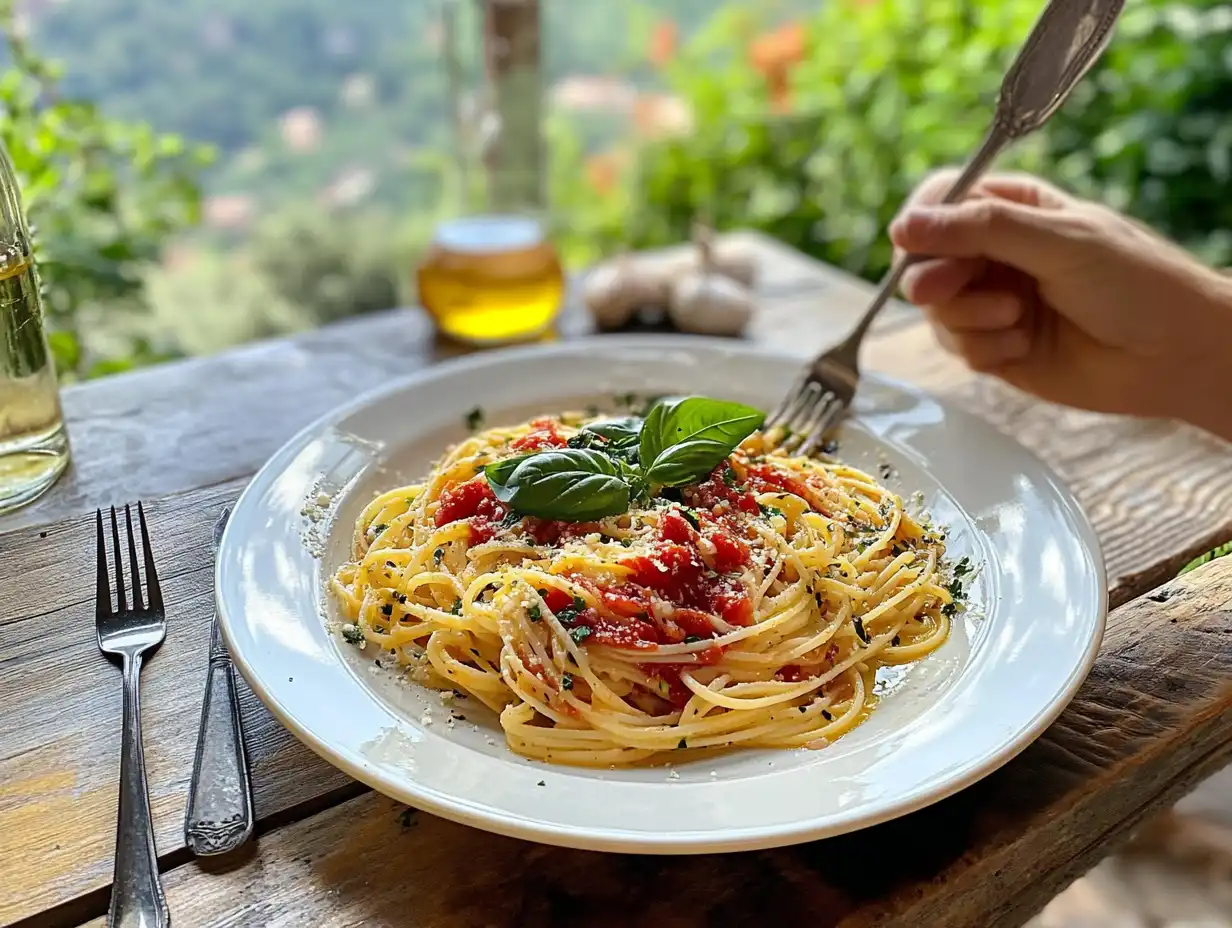Table of contents
Introduction
Capellini pasta, often referred to as “angel hair,” is one of the most delicate and refined types of pasta in Italian cuisine. Known for its ultra-thin strands and light texture, it pairs beautifully with simple sauces, offering a delightful balance of flavor and elegance. Originating in Italy, capellini has a long-standing tradition in both home kitchens and gourmet dining establishments.
This guide will explore everything you need to know about capellini pasta—from its history and cooking techniques to pairing it with the perfect sauces. Whether you’re a novice cook or a pasta aficionado, you’ll find inspiration and tips to elevate your culinary skills with this versatile ingredient.
What is Capellini Pasta?
Definition and Characteristics
Capellini, derived from the Italian word for “little hair,” is a type of pasta known for its extremely fine and delicate strands. Measuring about 0.85mm to 0.92mm in diameter, it is one of the thinnest types of pasta, making it an ideal choice for light, quick-to-prepare dishes. While many confuse it with angel hair pasta, capellini is slightly thicker, giving it a more versatile texture.
The pasta’s delicate nature allows it to absorb flavors quickly, making it a perfect match for light sauces like olive oil, butter, or fresh tomato-based condiments. Its quick cooking time—typically around 2-4 minutes—adds to its appeal for creating elegant meals in a short amount of time.
How Capellini Differs from Other Pasta
When compared to other types of pasta, capellini stands out for its:
- Thinness: Among the finest strands in the pasta world.
- Cooking Speed: Cooks significantly faster than thicker varieties like spaghetti or fettuccine.
- Texture: Light and airy, complementing delicate ingredients without overpowering them.
- Pairing Ability: Best suited for lighter sauces rather than heavy, cream-based ones.
Culinary Uses of Capellini
Capellini’s versatile nature lends itself to a variety of dishes:
- Light Sauces: Tossed with olive oil, garlic, or fresh herbs.
- Seafood Pairings: Ideal with shrimp, scallops, or clams.
- Soups: A perfect addition to broths for a refined touch.
- Cold Pasta Salads: A lighter alternative for refreshing summer recipes.
Understanding capellini’s unique attributes helps in preparing dishes that highlight its delicate texture and refined taste.
History of Capellini Pasta
The Origins of Capellini Pasta
Capellini pasta traces its roots back to Italy, the cradle of pasta innovation. Its name, meaning “little hair,” reflects its fine, slender strands that have long been cherished in Italian households. Capellini has historically been associated with regions known for their culinary traditions, such as Liguria and Campania, where fresh, simple ingredients are celebrated.
In the early days, capellini was crafted by hand, a meticulous process requiring precision and skill. The fine strands were traditionally paired with fresh, seasonal produce and light oils, epitomizing the essence of Italian cuisine—simplicity and quality.
Traditional Uses in Italian Cuisine
Capellini has been a staple in Italian kitchens for centuries, often served during family gatherings or festive occasions. In its classic preparation, capellini is:
- Served with Simple Sauces: Olive oil, garlic, and fresh herbs were common pairings.
- Used in Broths: A comforting addition to light, clear soups.
- Celebrated in Summer Dishes: Capellini’s delicate texture pairs well with fresh tomatoes and basil, making it ideal for warm-weather meals.
The thin pasta was also a practical choice in regions with limited cooking fuel, as its short boiling time conserved resources.
Capellini in Modern Culinary Culture
Today, capellini has gained international acclaim, featuring prominently in both home kitchens and upscale restaurants. It has adapted well to diverse culinary traditions, blending seamlessly into recipes inspired by Asian, Mediterranean, and even fusion cuisines.
Despite its evolution, capellini remains a symbol of Italian culinary heritage, embodying the balance of elegance and simplicity. Its growing popularity worldwide underscores its timeless appeal and versatility.
Capellini vs. Angel Hair: Key Differences and Similarities
Understanding the Confusion
Capellini and angel hair pasta are often used interchangeably due to their similar appearance. Both feature ultra-thin strands, making them ideal for light, quick meals. However, subtle differences set them apart in terms of texture, thickness, and culinary applications.
Differences Between Capellini and Angel Hair
- Thickness:
- Capellini is slightly thicker, with a diameter ranging from 0.85mm to 0.92mm.
- Angel hair, or “capelli d’angelo,” is even thinner, measuring closer to 0.78mm to 0.88mm.
The difference, while small, can influence the cooking process and texture of the dish.
- Texture:
- Capellini has a firmer bite due to its marginally thicker strands, making it more versatile.
- Angel hair is softer and more delicate, requiring gentler handling to avoid breaking.
- Culinary Preferences:
- Capellini pairs well with a wider range of sauces, from light oil-based ones to slightly richer tomato sauces.
- Angel hair is best suited for ultra-light accompaniments, such as infused oils or broths.
- Cooking Time:
- Capellini cooks in about 2-4 minutes, providing a firmer texture if not overcooked.
- Angel hair takes about 1-2 minutes, demanding even closer attention.
Similarities Between Capellini and Angel Hair
- Appearance: Both are fine, slender pasta types that look nearly identical to the untrained eye.
- Pairing Options: Both work well with light, delicate ingredients, ensuring the pasta remains the star of the dish.
- Quick Cooking: Their thinness makes them ideal for fast, last-minute meals.
When to Choose Capellini or Angel Hair
- Choose Capellini:
Opt for capellini when you’re working with slightly thicker or more flavorful sauces, such as a classic Pomodoro or light cream-based dishes. - Choose Angel Hair:
Angel hair is perfect for dishes where the pasta is meant to subtly complement other elements, such as seafood or light oil and herb preparations.
Understanding these distinctions helps ensure the right pasta choice for your dish, enhancing the flavor and overall dining experience.
How to Cook Capellini Pasta: Tips for Perfect Results

Step-by-Step Instructions for Cooking Capellini
Cooking capellini pasta may seem straightforward, but its delicate nature requires precision to avoid overcooking. Follow these steps to achieve the perfect texture:
- Prepare the Ingredients:
- Measure about 2 ounces (56 grams) of dried capellini per serving.
- Select your preferred sauce or toppings, keeping them ready to combine quickly.
- Boil Water:
- Use a large pot to ensure the pasta has enough room to move freely.
- Add 4-6 quarts (approximately 4-6 liters) of water per pound of pasta.
- Season the water generously with salt—about 1-2 tablespoons.
- Cook the Capellini:
- Add the pasta to boiling water and stir immediately to prevent clumping.
- Capellini typically cooks in 2-4 minutes. Start checking for doneness at 2 minutes to achieve the ideal al dente texture.
- Drain the Pasta:
- Use a colander to drain the pasta, reserving a small amount (about ½ cup) of the cooking water to adjust the sauce if necessary.
- Avoid rinsing the pasta unless it will be used in a cold dish.
- Combine with Sauce:
- Toss the cooked pasta immediately with your prepared sauce to prevent sticking.
- For a lighter texture, add a splash of the reserved pasta water while mixing.
Expert Tips for Cooking Capellini
- Don’t Overcook: Due to its thinness, capellini can become mushy in seconds. Set a timer and taste-test early.
- Use Fresh Ingredients: The simplicity of capellini dishes means that high-quality ingredients, like fresh tomatoes or extra virgin olive oil, make a significant difference.
- Toss Before Serving: Always toss the pasta with sauce before serving to ensure even coating.
- Serve Immediately: Capellini tastes best fresh. If left sitting, it can become sticky or clump together.
Common Mistakes and How to Avoid Them
- Adding Pasta to Cold Water: Always boil the water before adding capellini to ensure even cooking.
- Not Using Enough Water: Crowded pasta doesn’t cook evenly; use a large pot with plenty of water.
- Skipping Salt: Salt enhances the pasta’s natural flavor, so don’t skip this step.
- Overcooking: Stay vigilant—capellini’s quick cook time leaves little room for error.
Cooking Capellini for Different Dishes
- For Soups: Break capellini into shorter pieces before adding them to broth to make eating easier.
- For Salads: Rinse the cooked pasta under cold water to stop the cooking process and remove excess starch.
- For Sauced Dishes: Combine capellini directly with warm sauce, allowing it to absorb the flavors.
Mastering the art of cooking capellini ensures a delightful dining experience every time, whether you’re preparing a quick weeknight dinner or an elegant meal for guests.
Popular Capellini Pasta Recipes
Capellini pasta’s delicate strands and quick cooking time make it an ideal choice for a variety of classic and innovative dishes. Below are some popular recipes that highlight the versatility and elegance of capellini.
1. Capellini Aglio e Olio (Garlic and Oil)

This classic Italian dish is a minimalist masterpiece, featuring just a few ingredients that come together for an explosion of flavor.
Ingredients:
- 12 ounces (340g) capellini pasta
- 4 tablespoons extra virgin olive oil
- 4 cloves garlic, thinly sliced
- 1 teaspoon crushed red pepper flakes
- Fresh parsley, chopped (for garnish)
- Salt and pepper to taste
Instructions:
- Cook the capellini pasta according to package instructions until al dente. Reserve ½ cup of pasta water.
- In a large skillet, heat olive oil over medium heat. Add garlic and sauté until golden brown, being careful not to burn it.
- Add the red pepper flakes and stir briefly.
- Toss the cooked capellini into the skillet, adding reserved pasta water as needed to loosen the mixture.
- Season with salt and pepper, garnish with parsley, and serve immediately.
2. Capellini al Pomodoro (Tomato Sauce)
This traditional recipe combines capellini with a vibrant and flavorful tomato sauce.
Ingredients:
- 12 ounces (340g) capellini pasta
- 1 can (28 ounces) San Marzano tomatoes
- 3 tablespoons olive oil
- 3 cloves garlic, minced
- Fresh basil leaves, torn
- Salt and sugar to taste
- Grated Parmesan cheese (optional)
Instructions:
- Heat olive oil in a saucepan over medium heat. Add garlic and sauté until fragrant.
- Crush the tomatoes and add them to the pan, along with their juices. Simmer for 15-20 minutes.
- Season with salt and a pinch of sugar to balance the acidity. Stir in fresh basil leaves.
- Cook capellini until al dente, then toss it in the tomato sauce.
- Serve hot, topped with grated Parmesan if desired.
3. Capellini with Lemon Butter and Shrimp
This seafood-inspired dish elevates capellini to gourmet status.
Ingredients:
- 12 ounces (340g) capellini pasta
- 12-16 medium shrimp, peeled and deveined
- 4 tablespoons butter
- 2 tablespoons olive oil
- 2 cloves garlic, minced
- Juice and zest of 1 lemon
- Fresh parsley, chopped
Instructions:
- Cook the capellini pasta until al dente. Reserve ½ cup of pasta water.
- In a large skillet, melt butter and olive oil over medium heat. Add garlic and sauté for 1-2 minutes.
- Add shrimp and cook until pink and opaque. Stir in lemon juice and zest.
- Toss the capellini with the shrimp mixture, adding reserved pasta water for consistency.
- Garnish with parsley and serve immediately.
4. Capellini Primavera (Vegetable Medley)
A light and colorful dish perfect for spring and summer.
Ingredients:
- 12 ounces (340g) capellini pasta
- 1 zucchini, sliced thin
- 1 yellow squash, sliced thin
- 1 cup cherry tomatoes, halved
- 1 bell pepper, julienned
- 3 tablespoons olive oil
- 2 cloves garlic, minced
- Salt, pepper, and grated Parmesan for garnish
Instructions:
- Cook the capellini pasta and set aside.
- In a large skillet, heat olive oil and sauté garlic until fragrant. Add the vegetables and cook until tender-crisp.
- Toss the pasta with the sautéed vegetables and season with salt and pepper.
- Garnish with grated Parmesan and serve warm.
5. Cold Capellini Salad with Pesto
This refreshing dish is perfect for hot days or as a side dish.
Ingredients:
- 12 ounces (340g) capellini pasta
- 1 cup basil pesto (store-bought or homemade)
- 1 cup cherry tomatoes, halved
- ½ cup mozzarella pearls
- 2 tablespoons olive oil
Instructions:
- Cook the capellini and rinse under cold water to stop the cooking process. Drain well.
- Toss the pasta with pesto, olive oil, cherry tomatoes, and mozzarella.
- Chill in the refrigerator for 30 minutes before serving.
These recipes showcase the versatility of capellini pasta, offering options for every palate and occasion. Whether you prefer something traditional or a modern twist, capellini provides a perfect canvas for culinary creativity.
FAQs About Capellini Pasta
1. Is capellini the same as angel hair pasta?
Not exactly. Capellini and angel hair pasta are very similar but not identical. Capellini is slightly thicker, with a diameter ranging from 0.85mm to 0.92mm, while angel hair pasta is thinner, measuring closer to 0.78mm to 0.88mm. Both are delicate and suited for light sauces, but capellini has a slightly firmer bite.
2. What pasta is closest to capellini?
Angel hair pasta (capelli d’angelo) is the closest to capellini in terms of size and texture. If neither is available, thin spaghetti or vermicelli can serve as a substitute, though these options are slightly thicker and less delicate.
3. What is capellini pasta good for?
Capellini pasta is perfect for light and quick dishes. Its fine strands are ideal for:
- Oil-based sauces (like Aglio e Olio).
- Fresh tomato-based sauces.
- Light seafood dishes.
- Cold pasta salads.
- Adding to soups and broths for a refined touch.
Its delicate texture absorbs flavors well, making it a versatile choice for simple yet elegant meals.
4. Can you use capellini for spaghetti?
Yes, capellini can be used as a substitute for spaghetti in recipes, especially for lighter sauces. However, its finer texture may not hold up as well with heavy or chunky sauces that are typically paired with spaghetti. Adjust cooking time as capellini cooks faster than spaghetti.
5. What is the best pasta for weight loss?
The best pasta for weight loss includes whole wheat, lentil, chickpea, and konjac (shirataki) pasta. These options are high in fiber or protein and low in calories, making them ideal for weight management when paired with healthy toppings and portion control.
6. What is Capellini d’Angelo pasta called?
Capellini d’Angelo is commonly known as “angel hair pasta” in English. The name translates to “angel’s hair” in Italian, reflecting its ultra-thin and delicate strands. It’s a variation of capellini pasta, marketed as the thinnest type, and is often used for light dishes with oil-based sauces or in broths due to its quick cooking time and fine texture.
7. How long to cook capellini ?
Capellini, also known as angel hair pasta, typically cooks in 2 to 4 minutes. For the best results:
- Dry Capellini: Boil for 3 to 4 minutes.
- Fresh Capellini: Cooks faster, in about 1 to 2 minutes.
- Al Dente: Reduce the time by 30 seconds to 1 minute, tasting to ensure it’s firm but tender.
Always refer to the package instructions and test the pasta early to avoid overcooking.
Explore Related Recipes for Capellini Pasta
To enrich your understanding of pasta varieties and elevate your Capellini Pasta dishes, explore these related recipes and articles:
- Discover the vibrant flavors of Mexican Green Spaghetti: A Flavorful Fusion of Creamy and Spicy for a unique pasta twist.
- Learn creative ways to transform your pasta repertoire with Green Spaghetti: A Delicious Twist to Classic Pasta.
- Dive into another quick pasta option with Ditalini Pasta: A Culinary Delight and Versatile Ingredient to explore its uses and flavors.
Conclusion
Capellini pasta, with its fine, delicate strands, is a testament to the elegance and simplicity of Italian cuisine. Its versatility makes it a favorite among home cooks and professional chefs alike, seamlessly fitting into a variety of dishes—from light, oil-based sauces to refreshing cold pasta salads. With a rich history rooted in Italian tradition, capellini continues to delight pasta enthusiasts worldwide.
Whether you’re crafting a quick weeknight meal or experimenting with gourmet recipes, capellini offers endless possibilities. By understanding its unique attributes and pairing it thoughtfully with sauces and ingredients, you can create dishes that are as delicious as they are refined.
So, grab a package of capellini pasta, try your hand at the recipes provided, and savor the artistry of this exquisite Italian staple. Buon appetito!
